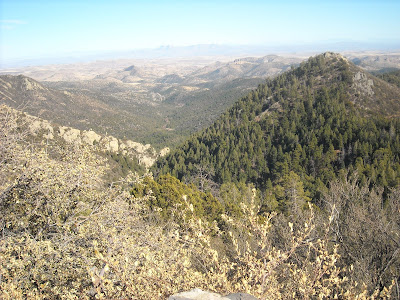We moved toward the center of the state where a friend had recommended great fishing opportunities. These were dam created lakes on sections of the Rio Grande. The water levels were very low in the lakes, and when a camp host said he had not seen anyone catching fish from the shore, that a boat was really necessary for any fishing, the tackle box was buried back where it had been hidden under chairs and books.

Our next stop was to be Silver City on the western side of NM. While in Seminole State Park, we had met a couple who were headed there to be hosts at the Gila cliff dwelling site. They loved Silver City so we decided to check it out. The trip took us over a pass with a view of the White Sands National Monument in Alamogordo. In New Mexico, it seems you drive for miles and miles in flat, dry, scrubby desert, when suddenly you are climbing through ancient, uplifted layers of limestone or magma outcroppings, over six or eight thousand foot passes and down through spectacular views of more flat dry desert.
The white sand that make up the dunes in White Sands National Monument are created from gypsum deposits laid down millions of years ago. Wikipedia explains it like this:
Gypsum is rarely found in the form of sand because it is water-soluble. Normally, rain would dissolve the gypsum and carry it to the sea. Since the Tularosa Basin has no outlet to the sea, rain that dissolves gypsum from the surrounding San Andres and Sacramento Mountains is trapped within the basin, and the rain either sinks into the ground or forms shallow pools which subsequently dry out and leave gypsum in a crystalline form, called selenite, on the surface.


 A bridge built over a steep gorge on one of the mountain passes in NM
A bridge built over a steep gorge on one of the mountain passes in NM

Another pass in New Mexico


There were several industrial mines scattered in the mountains of southern NM. You cannot even see the bottom they are so deep. This one has been worked since the late 1800's


Our stop in Silver City ended up consisting of only one night. The weather report was for a severe cold front arriving the next night with snow in the mix. Life in our rig can be tolerated with temps in the mid 30's, but below that, or snow, is just more than the pop-up (or us) can tolerate. So again, we changed plans and moved on to Arizona, hoping to avoid the worst of the weather. After stopping to visit a cousin in Tucson, temps were still predicted to be near freezing that night, so we opted for a hotel.
 Sunday morning this was the view out our hotel window
Sunday morning this was the view out our hotel window and through the windshield of our truck. Tucson received 3 inches of snow overnight. Now I realize that even mentioning three inches is laughable considering the three feet on the ground in Maine, but for Tucson, which is usually in the 70's this time of year, it was a big deal.
and through the windshield of our truck. Tucson received 3 inches of snow overnight. Now I realize that even mentioning three inches is laughable considering the three feet on the ground in Maine, but for Tucson, which is usually in the 70's this time of year, it was a big deal.
No comments:
Post a Comment